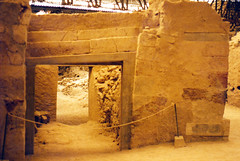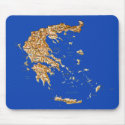Last night (Wednesday 2nd June 2010) BBC2 broadcast a Timewatch Special, presented by Bettany Hughes, entitled Atlantis: The Evidence examining the background to the legend.
The programme concentrated on the eruption over three and a half millena ago of the volcano that formed the islands that are now Santorini and the Minoan civilisation on the island of Crete.
One of the locations featured was the archaeological site of the Minoan city at Akrotiri which was discovered in 1967. At the time of my visit to Santorini it was open to the public, unfortunately this is no longer the case. A roof had been constructed over the ruins to protect them from the elements, however in 2005 part of it collapsed causing the death of a visitor and the site has remained closed since, although I understand it is intended to reopen it in the future.
Akrotiri has yielded some amazing artifacts giving us real insight into Europe's first civilisation, particularly interesting are the frescoes now on display in the National Archaeological Museum in Athens.
Other items discovered during the excavations are now displayed in a local museum some distance from the site.
Wikipedia has a detailed articles on the Akrotiri Archaeological Site and Santorini.
Thursday, 3 June 2010
Tuesday, 25 May 2010
Patmos; Miracle of St John the Divine and the Wizard
 I photographed this mosaic on the end wall of a chapel that stands by the harbour of Skala, Patmos's main town, which illustrates a local legend concerning St John the Divine. The story goes that when he arrived on the island the saint found that there was a wicked wizard, a follower of the devil, already living there who challenged him to a trial of spiritual strength claiming that he (the wizard) under Satan's protection could dive into the sea, retrieve the bodies of drowned sailors and bring them back to life. St John asked him for a demonstration of his powers and the wizard duly threw himself into the water whereupon St John prayed for assistance and God intervened cutting off the Devil's powers causing the wizard to drown and turn into a rocky outcrop in the harbour.
I photographed this mosaic on the end wall of a chapel that stands by the harbour of Skala, Patmos's main town, which illustrates a local legend concerning St John the Divine. The story goes that when he arrived on the island the saint found that there was a wicked wizard, a follower of the devil, already living there who challenged him to a trial of spiritual strength claiming that he (the wizard) under Satan's protection could dive into the sea, retrieve the bodies of drowned sailors and bring them back to life. St John asked him for a demonstration of his powers and the wizard duly threw himself into the water whereupon St John prayed for assistance and God intervened cutting off the Devil's powers causing the wizard to drown and turn into a rocky outcrop in the harbour.There is indeed a rocky outcrop in the harbour and is marked with a buoy as it constitutes a hazard to larger vessels.
The mosaic shows the wizard drowning (bottom left), St John twice (Bottom right and top centre, praying with another saint) while the Devil (Centre) waves his arms about ineffectually as the hand of God appears in the sky (Very small, just right of top centre). For those with very good eyesight and a knowledge of Greek, across the top there is the inscription 'The miracle of St John the Divine'.

Mosaic of St. John, Monastery of St. John, Patmos, Dodecanese, Greek Islands, Greece, Europe
Photographic Print
Beatty, David
18 in. x 24 in.
Buy at AllPosters.com
Framed Mounted
Monday, 3 May 2010
Photo Montage of Rhodes Town

As I mentioned in a earlier post, Rhodes old town is a great place to just wander and take in the views.
So, here is a montage of photographs that I took
during my visit without too many words.
These photographs and more can be seen in my Aegean Journey photo set at Flickr.

This work by Roland Turner is licensed under a Creative Commons Attribution-Share Alike 2.0 UK: England & Wales License.
Sunday, 18 April 2010
The Cave of the Apocalypse, Patmos
The island of Patmos is the location, where St John the Divine (Aghios Ionanis Theogolos in Greek) is reputed to have written the Book of Revalation also known as the Apocalypse, the ultimate section of the Bible, around 90-100 AD.
A Monastry now stands on the site of the 'cave' where he is believed to have lived and written his vision of the the end of the world, containing a museum with many exhibits and gifts from world leaders through the ages. One of the most interesting of which is the deed granting the site to the monastry written on purple velum, issued by the Byzantine Emperor, Alexios I Comnenus.
The cave (entrance above), were it not for the walls enclosing it, would be more accurately described as rocky overhang on the steep hillside affording only a little shelter from the elements. At its deepest point there is a ledge which it is claimed St John used as a bed, however even the the most devout would have to be sceptical about this. Surely even saints are subject to the law of gravity, the ledge is at such a steep angle that, unless he had some sort of harness strapping him to the rocks, he would have woken up every morning at the bottom of the hill!
Whether St John the Divine was the same John as John the Apostle, which would mean that he must have been very old , or a separate individual, as most modern scholars believe, he had been exiled here by the Roman Emperor Domitian. Patmos, as a place of exile, is not like Siberia in fact it is difficult to understand how St John had such dark visions in such as pleasant locale - the picture to the right is the view from the outside of his cave!

This work by Roland Turner is licensed under a Creative Commons Attribution-Share Alike 2.0 UK: England & Wales License.
A Monastry now stands on the site of the 'cave' where he is believed to have lived and written his vision of the the end of the world, containing a museum with many exhibits and gifts from world leaders through the ages. One of the most interesting of which is the deed granting the site to the monastry written on purple velum, issued by the Byzantine Emperor, Alexios I Comnenus.
The cave (entrance above), were it not for the walls enclosing it, would be more accurately described as rocky overhang on the steep hillside affording only a little shelter from the elements. At its deepest point there is a ledge which it is claimed St John used as a bed, however even the the most devout would have to be sceptical about this. Surely even saints are subject to the law of gravity, the ledge is at such a steep angle that, unless he had some sort of harness strapping him to the rocks, he would have woken up every morning at the bottom of the hill!
Whether St John the Divine was the same John as John the Apostle, which would mean that he must have been very old , or a separate individual, as most modern scholars believe, he had been exiled here by the Roman Emperor Domitian. Patmos, as a place of exile, is not like Siberia in fact it is difficult to understand how St John had such dark visions in such as pleasant locale - the picture to the right is the view from the outside of his cave!

This work by Roland Turner is licensed under a Creative Commons Attribution-Share Alike 2.0 UK: England & Wales License.
Thursday, 15 April 2010
Rhodes Old Town
The old town of Rhodes is a fascinating place with more history than you can take in during a short visit. Wandering through its narrow streets you will come across reminders of the Knights Hospitaler of St John, derelict Turkish mosques and twentieth century Italian architecture.
Of course it is famed as the site of the Colossus of Rhodes, one of the Seven Wonders of the Ancient World. The huge, 30 metre tall statue of the sun god Helios stood for ony 56 years,being destroyed by an earthquake in 226 BC, it has traditionally been portrayed stradling the entrance to the Mandraki harbour. However this a myth resulting from fanciful travellers' tales of the middle ages, its actual location is not known for certain and according to at least one achaeologist may have been some distance fron Rhodes Town on a hill now known as Monte Smith.
Wikipedia article - Colossus of Rhodes.

This work by Roland Turner is licensed under a Creative Commons Attribution-Share Alike 2.0 UK: England & Wales License.
Of course it is famed as the site of the Colossus of Rhodes, one of the Seven Wonders of the Ancient World. The huge, 30 metre tall statue of the sun god Helios stood for ony 56 years,being destroyed by an earthquake in 226 BC, it has traditionally been portrayed stradling the entrance to the Mandraki harbour. However this a myth resulting from fanciful travellers' tales of the middle ages, its actual location is not known for certain and according to at least one achaeologist may have been some distance fron Rhodes Town on a hill now known as Monte Smith.
Wikipedia article - Colossus of Rhodes.

This work by Roland Turner is licensed under a Creative Commons Attribution-Share Alike 2.0 UK: England & Wales License.
Monday, 12 April 2010
Santorini/Thira Sunset
Santorini, or Thira as it is also known, is noted for its spectacular sunsets and during my stay I spent several evenings at different locations around the island's capital (also called Thira) trying to capture the constantly changing hues on film.
This picture is probably my favorite, the small sailing vessel entering the caldera somehow is evocative of the Greek islands and helps to give scale to the image.

This work by Roland Turner is licensed under a Creative Commons Attribution-Share Alike 2.0 UK: England & Wales License.
This picture is probably my favorite, the small sailing vessel entering the caldera somehow is evocative of the Greek islands and helps to give scale to the image.

This work by Roland Turner is licensed under a Creative Commons Attribution-Share Alike 2.0 UK: England & Wales License.
Subscribe to:
Comments (Atom)





















